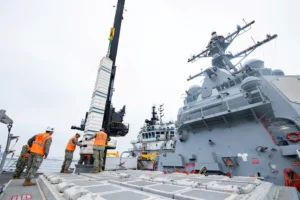The Navy this week hired Hunter Stires to serve as “Maritime Strategist” for the Secretary of the Navy, where he will focus on maritime statecraft, competition and priorities like re-arming the Vertical Launch Systems (VLS) at-sea.
In a Jan. 17 post on X, formerly Twitter, Stires said he will be reporting to Secretary of the Navy Carlos Del Toro’s senior adviser, Steve Brock.
Stires previously worked at think tanks and Navy contractors, but currently serves as a project director at the U.S. Naval Institute Maritime Counterinsurgency Project, a fellow at the Naval War College and non-resident fellow at the Navy League’s Center for Maritime Strategy.
as well as @SECNAV priority initiatives including Vertical Launch System at-sea rearming. I’m thrilled to be officially coming aboard SECNAV’s team and look forward to the work ahead. 2/2
— Hunter Stires (@HunterStires) January 18, 2024
Del Too first called for a new maritime statecraft in a speech at Harvard University’s Kennedy School of Government in September. He characterized it as a whole-of-government approach to build U.S. and allied commercial and naval maritime power (Defense Daily, Sept. 29, 2023).
During his speech at the Surface Navy Association’s annual symposium last week, Del Toro said the “near-term deterrent effect” of fielding a missile-re-arming system called the Transportable Re-Arming Mechanism (TRAM) “cannot be overstated – and we remain on track for the all-important at-sea demonstration I’ve directed to take place no later than this summer.”
He said TRAM is designed to allow the “rapid reload” of VLS cells in up to sea state 5 conditions, using the fleet’s existing interfaces.
Speaking to reporters following his remarks at the event, Del Toro confirmed he believed the VLS re-arm at sea capability will be operational within two to three years.
While he was reluctant to get into details, the Secretary said it will have a supply ship able to transfer missiles to a destroyer or future Constellation-class frigate at sea “and place them in the launcher in heavy seas, if necessary…So that ship doesn’t have to take a week to sail back to whatever port it might be resupplied at.”

Del Toro said the added time to resupply missiles only at port currently is a problem the service has to manage during the Red Sea conflict with the Houthis launching maritime attacks from Yemen.
“We’re working through it, and we’re managing it very effectively. But it means that we’ve got to take ships off station for greater periods of time to resupply them in a port and then get them back out to sea. This would allow it to be closer to the action, basically.”
Del Toro said the Navy decided to devote some additional funding to this project in fiscal years 2023 and ‘24 and will require some extra funding in FY ‘25.
He said once they demonstrate it, “it actually won’t take an enormous amount of funding either, it will take some additional funding, but not an enormous amount of funding, to apply it during future CNO availabilities.”